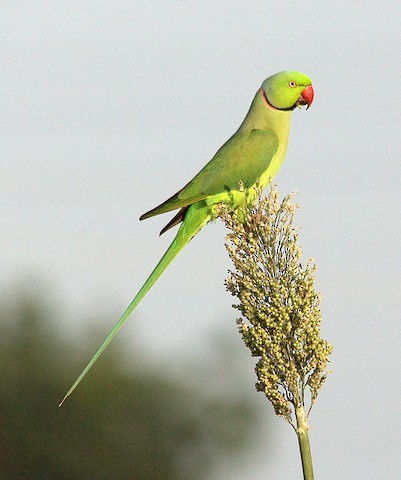Birdfinding.info ⇒ Common to locally abundant across much of its natural Asian range, nearly throughout India and Sri Lanka. Much more localized in its natural African range, where it is common mainly in coastal Senegal and Gambia. Introduced populations are especially conspicuous in: London, Amsterdam, Brussels, Paris, Lisbon, Madrid, Valencia, Barcelona, Rome, Istanbul, Israel (abundant from Ashdod and Jerusalem northward), Dubai, Singapore, and Tokyo. In the U.S., it is common throughout most of Kauai, Honolulu, and Bakersfield, California (especially Beale Park and the junction of Union and California Avenues), and can often be found in Los Angeles at Ballona Wetlands, and in Naples, Florida, along Tarpon Road.
Rose-ringed Parakeet
Psittacula krameri
Family: Psittaculidae
Sahelian Africa and southern Asia; introduced widely elsewhere. Inhabits various semiopen habitats including savannas, light woodlands, and agricultural and settled areas.
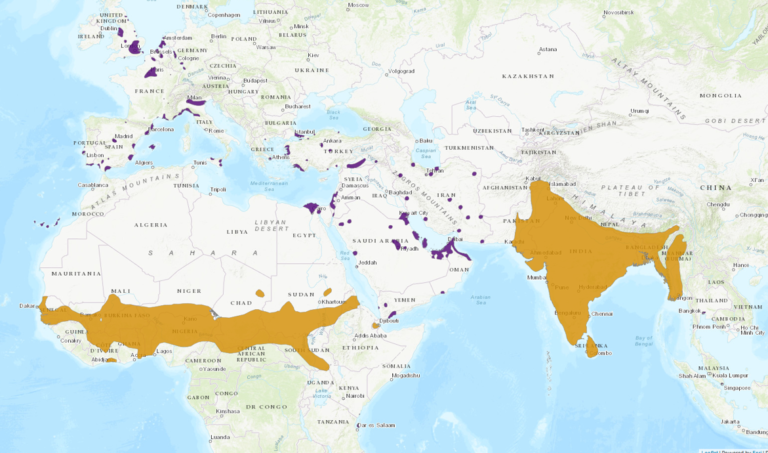
Approximate natural range of the Rose-ringed Parakeet (in orange) and locations of some introduced populations (in purple). © BirdLife International 2018
Natural range spans a large but discontinuous swath of the Old World tropics from West Africa to Southeast Asia.
In Africa, it occurs throughout the Sahel, occupying the savanna and agricultural belt from southwestern Mauritania, Senegal, and Guinea-Bissau east to Eritrea, Somaliland, and northern Uganda. Some urban populations around the edges of its natural range may be either natural or introduced: e.g., in Monrovia, Liberia, Abidjan, Côte d’Ivoire, and Djibouti.
In Asia, it occurs throughout most of the Indian subcontinent from northern and central Pakistan east to central Myanmar, north to the Himalaya foothills and south to Sri Lanka.
Popularity as a pet has led it to become one of the most widely introduced bird species, and it has adapted to cold temperate areas and desert areas where it relies on human agriculture and urban food sources.
In Europe populations are locally established, mostly in and around major urban areas, from southern Scotland, the Netherlands, central Germany, and southern Poland south to southern Spain, north-coastal Morocco, Mallorca, Sicily, Greece, Bulgaria, across Turkey (mainly around Istanbul, Izmir, Antalya, and Ankara), and south into the Middle East.
Also established in parts of Macaronesia: on the Canary Islands (Tenerife, Gran Canaria, Fuerteventura, and Lanzarote) and possibly the Azores (São Miguel) and Madeira.
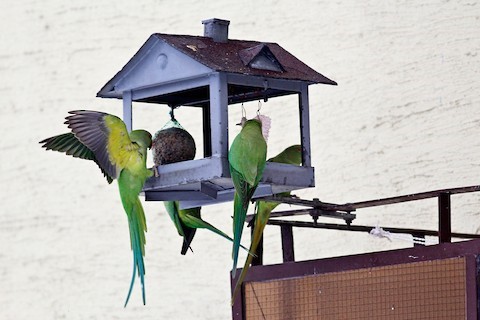
Rose-ringed Parakeets of the Polish population confirmed breeding in 2018. (Nysa, Poland; January 26, 2019.) © Tomasz Tanczuk
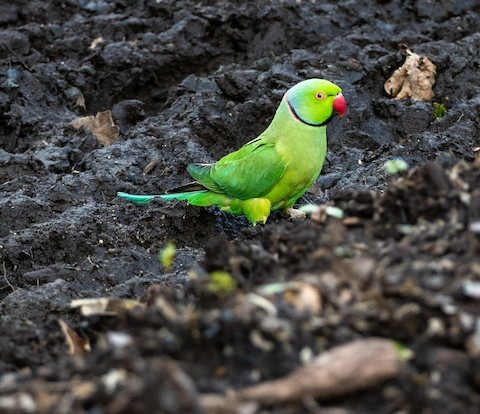
Rose-ringed Parakeet, male of a Scottish population. (Dawsholm Park, Glasgow, Scotland; March 31, 2020.) © Nick Giles
In the Middle East, it is well-established in Israel (nearly throughout), Egypt (northern and south along the Nile), Azerbaijan (Baku), Iran (mainly around Tehran, but locally around several cities), Saudi Arabia (around Riyadh and the Red Sea coast), and many areas along the Persian Gulf (in Kuwait, Bahrain, Qatar, and the United Arab Emirates), and Oman (coastal lowlands of the north and south).
In South Africa, populations are established in the combined metropolitan area of Johannesburg and Pretoria and in the coastal lowlands of KwaZulu-Natal.
In eastern Asia, populations appear to be established in Thailand (Chiang Mai and Bangkok), Malaysia (mostly in Kuala Lumpur), Singapore, south-coastal China (Hong Kong to Guangzhou), the Philippines (Manila area), and Japan (Tokyo).
In eastern Australia, small populations have been reported around Brisbane, Melbourne, and Wollongong.
In the U.S., it is well-established in Hawaii (Kauai and Oahu), southern California (especially Bakersfield and the southern San Joaquin Valley, less so in Los Angeles and San Diego), and southwestern Florida (Naples).
In the West Indies, populations are well-established on Jamaica (Kingston) and Barbados. Reports are inconclusive regarding more tenuously established populations on Aruba, Curaçao, Martinique, Puerto Rico, and St. Martin.
The lone South American population appears to be well-established in Caracas, Venezuela.
Identification
An exceptionally lean, long-tailed parakeet with a mostly red bill.
The plumage is almost entirely shades of green, except parts of the tail and wings. The upperside of the tail is dominated by two long, central feathers that are either blue or bluish-green, and the rest of the tail—visible from below or when spread—is mostly yellow. The undersides of the wings, prominent when seen in flight, are also yellow.
Males have a distinctive neck collar, similar to markings on other Psittacula, but thinner, more crisply drawn, making the head appear almost like a separately made attachment. The throat is mostly black, which continues as a thin line around the neck. On the sides of the neck, the collar also includes an adjacent pinkish line, which replaces the black line around the nape (this is the bird’s eponymous “rose ring”).
Females resemble males but without the distinctive head markings.
Bill color is somewhat variable, from bright coral-red to purplish. In many populations, the lower mandible is black, and in some the tip of the upper mandible is also black. In African subspecies (at least the nominate krameri) the upper mandible is mostly blackish with a dull, purplish base.
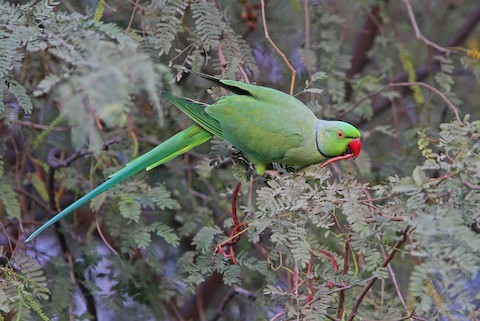
Rose-ringed Parakeet, male. (Al Qurm Natural Park, Masqat, Oman; October 31, 2010.) © Christoph Moning
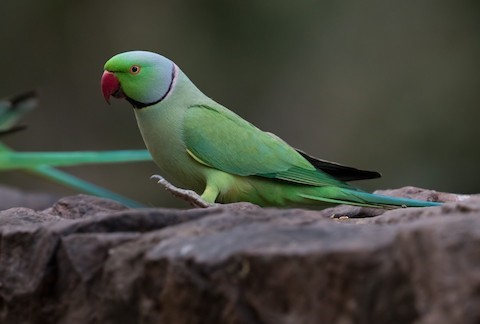
Rose-ringed Parakeet. (Ranthambore National Park, Rajasthan, India; December 30, 2015.) © Lars Petersson
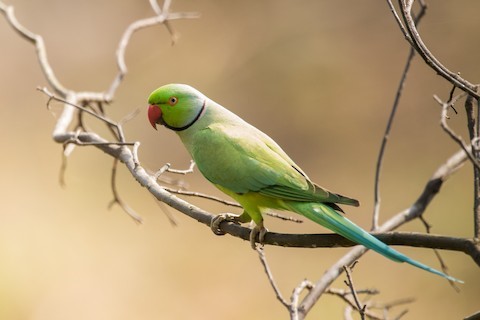
Rose-ringed Parakeet, male. (Nainital, Uttarakhand, India; April 1, 2018.) © Claudia Brasileiro
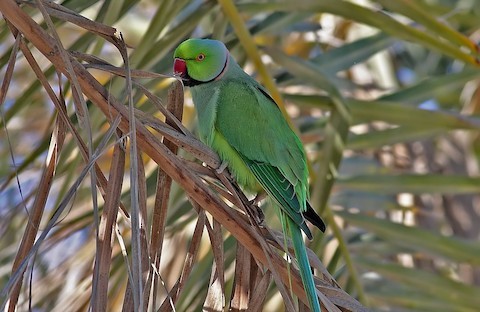
Rose-ringed Parakeet, male. (Al Khor, Al Khawr, Qatar; January 15, 2010.) © John Thompson
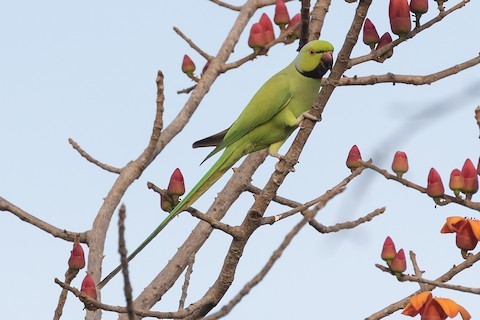
Rose-ringed Parakeet, P. k. krameri, male showing mostly blackish bill with dull-purplish base, typical of the nominate subspecies. (Tendaba, Gambia; January 2, 2019.) © James Kennerley
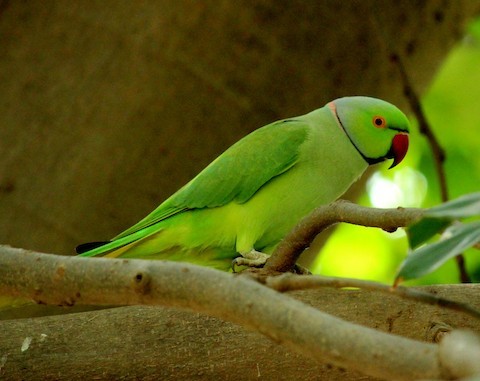
Rose-ringed Parakeet, male. (Thol Bird Sanctuary, Mahesana, Gujarat, India; September 5, 2015.) © Rajubhai Patel
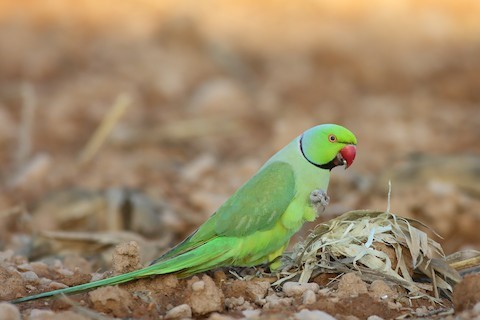
Rose-ringed Parakeet, male. (Salalah, Dhofar, Oman; December 21, 2016.) © Carlos Bocos

Rose-ringed Parakeet, males showing mostly bluish tails. (Varanasi, Uttar Pradesh, India; February 14, 2019.) © Michael Warner
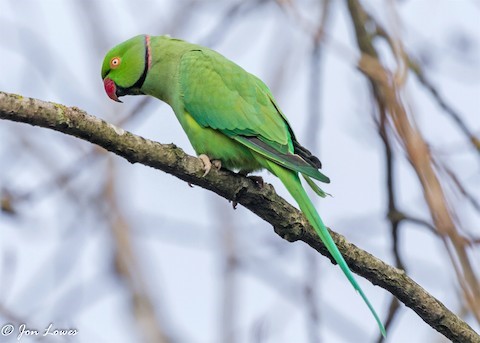
Rose-ringed Parakeet, male. (Erewash Canal, Derbyshire, England; October 9, 2017.) © Jon Lowes
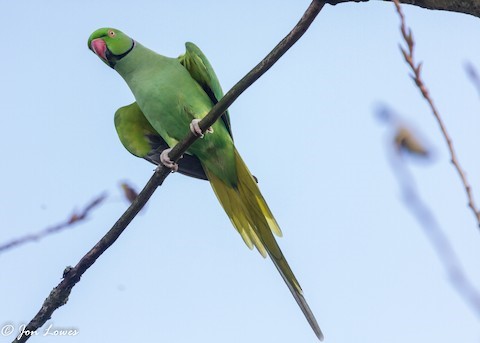
Rose-ringed Parakeet, male showing mostly yellowish undertail. (Erewash Canal, Derbyshire, England; October 9, 2017.) © Jon Lowes
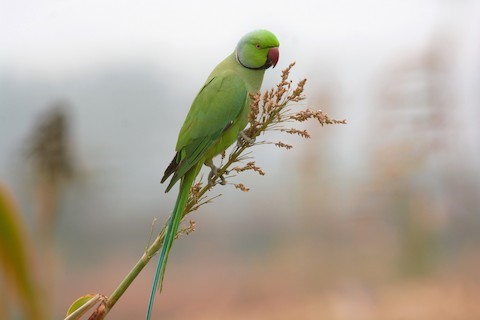
Rose-ringed Parakeet, male. (Anekal Dodda Kere, Bangalore, Karnataka, India; January 6, 2019.) © Prem Prakash Garg
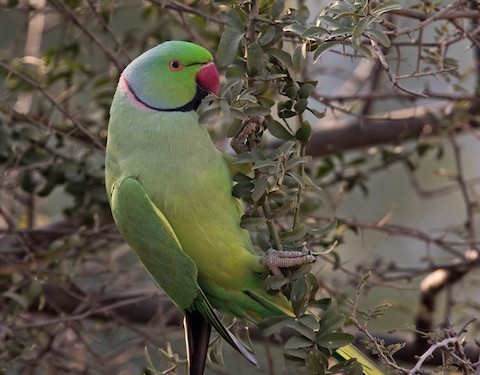
Rose-ringed Parakeet, male. (Chambal River, Agra, Uttar Pradesh, India; December 26, 2015.) © Lars Petersson
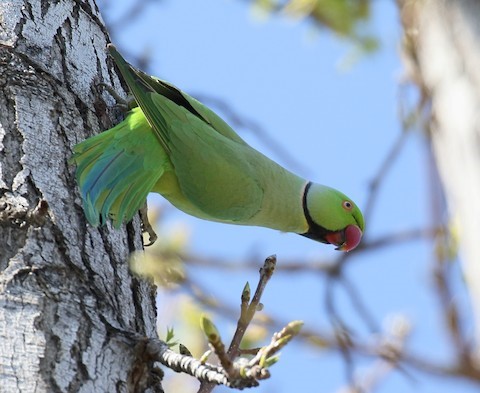
Rose-ringed Parakeet, male showing bluish tinge on central tail feathers. (Beale Park, Bakersfield, California; March 26, 2018.) © Sarah Lane
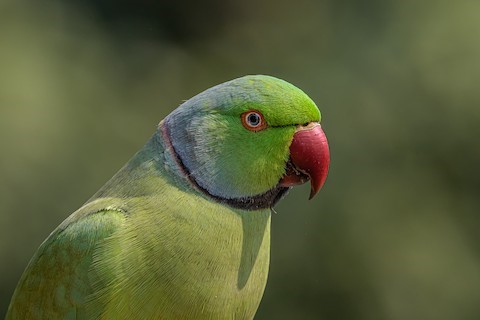
Rose-ringed Parakeet, male with all-red bill. (Deer Park, New Delhi, India; February 25, 2020.) © Nitin Chandra
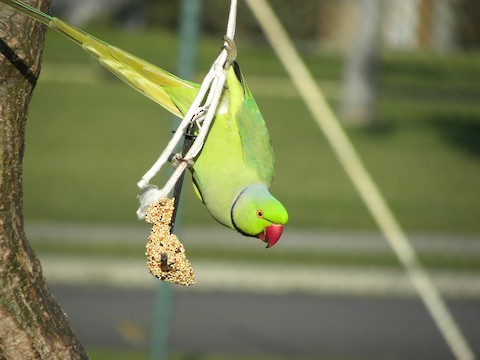
Rose-ringed Parakeet, male showing mostly yellowish undertail. (Camp Catline Road, Honolulu, Hawaii; January 19, 2017.) © Alex Moore
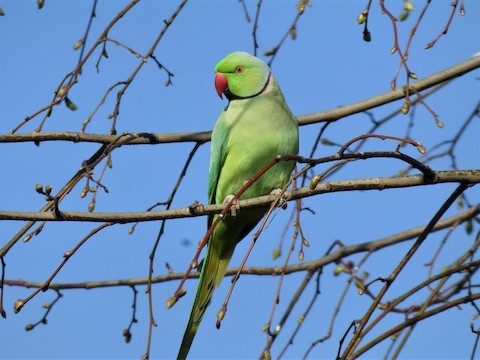
Rose-ringed Parakeet, male. (Lloyd Park, London, England; April 11, 2019.) © Graeme Spinks
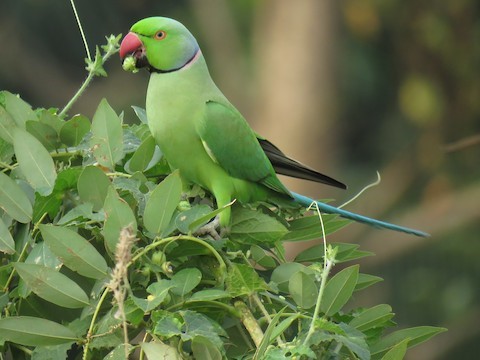
Rose-ringed Parakeet, male. (Walayar Reserve Forest, Palakkad, Kerala, India; December 24, 2017.) © Krishnamoorthy Muthirulan
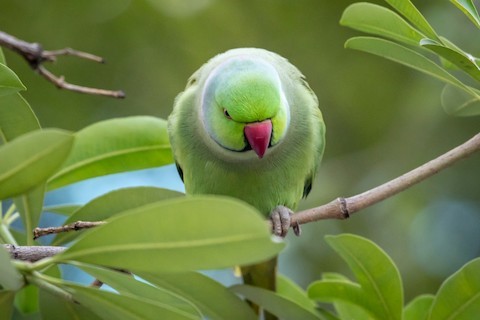
Rose-ringed Parakeet, male. (Shaheed Abdul Hamid Park, South Delhi, India; February 8, 2019.) © Michael Warner

Rose-ringed Parakeet, male (left) with females. (Ranthambore National Park, Rajasthan, India; December 30, 2015.) © Lars Petersson
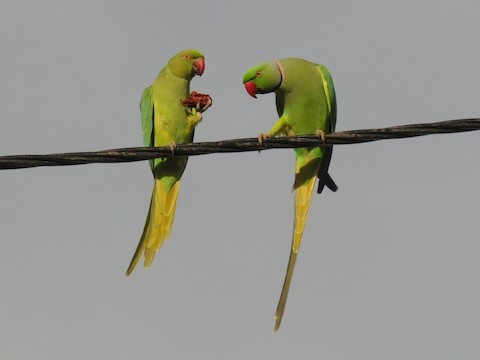
Rose-ringed Parakeet, female and male showing mostly yellow undertails. (Bankouale, Djibouti; October 18, 2018.) © Filipe Canário
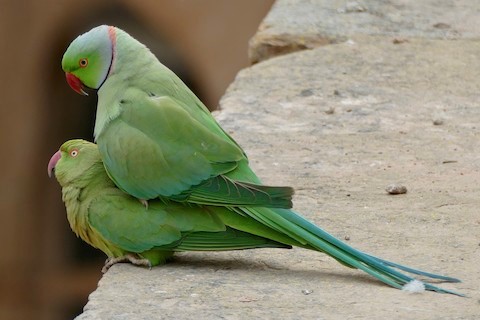
Rose-ringed Parakeet, male and female copulating. (Neemrana, Rajasthan, India; February 22, 2020.) © Peter Kaestner
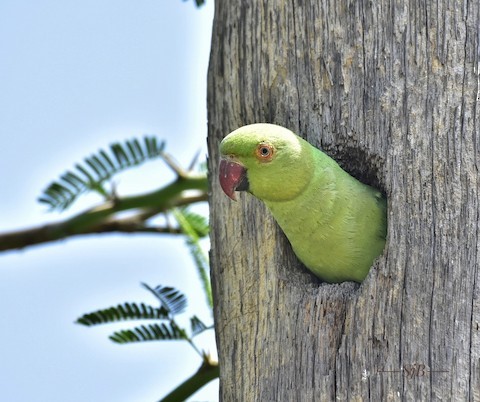
Rose-ringed Parakeet, female in nest cavity. (Ajit House, Murdi, Karnataka, India; March 9, 2019.) © Surajprakash B
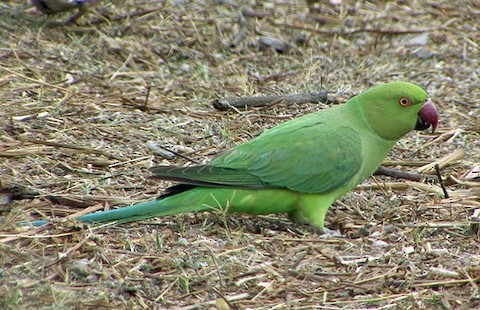
Rose-ringed Parakeet, female. (Tal Chhapar Sanctuary, Churu, Rajasthan, India; February 24, 2011.) © Josep del Hoyo
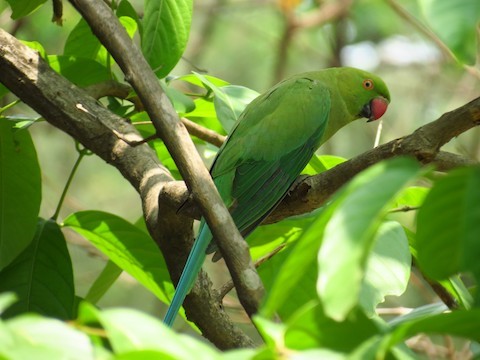
Rose-ringed Parakeet, female. (Kolkata, India; April 8, 2012.) © Soumyadeep Chatterjee
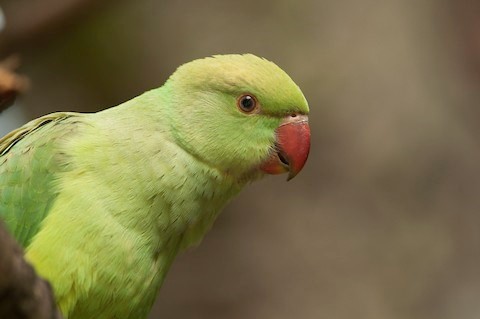
Rose-ringed Parakeet, female. (Beatrixpark, Amsterdam, Netherlands; July 2, 2012.) © Etienne Artigau
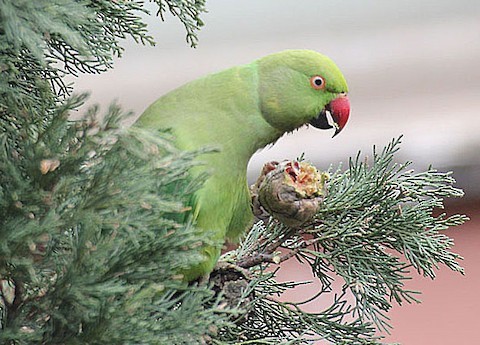
Rose-ringed Parakeet, female. (Rome, Italy; February 15, 2015.) © Raniero Massoli Novelli
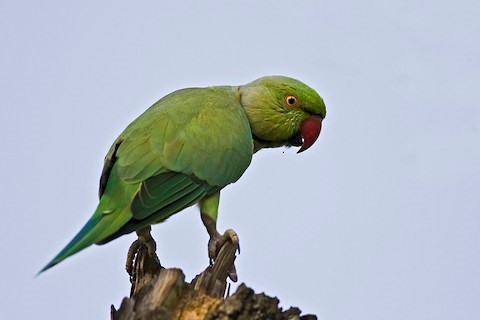
Rose-ringed Parakeet, female. (Islamabad, Pakistan; July 25, 2008.) © Zoltan Kovacs
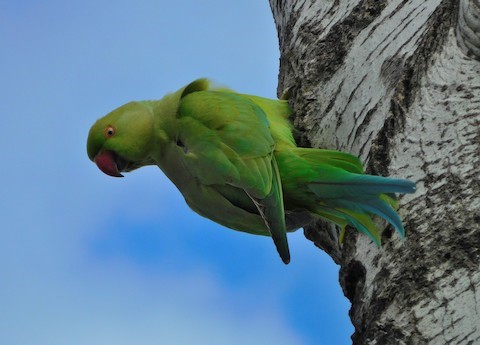
Rose-ringed Parakeet, female showing largely bluish central tail feathers. (Thermi, Macedonia, Greece; December 29, 2017.) © Theodosis Mamais
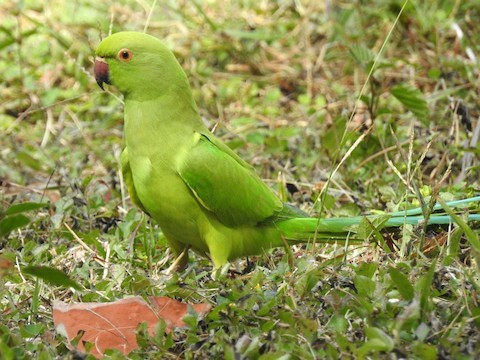
Rose-ringed Parakeet, female. (Flamingo, Everglades National Park, Florida; April 1, 2018.) © Luis Gonzalez
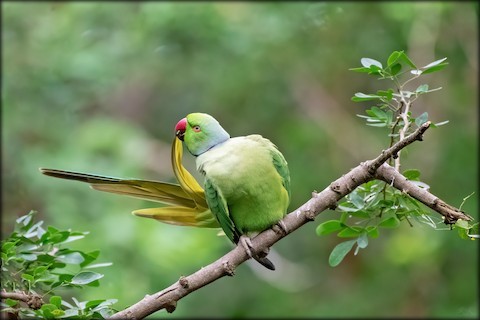
Rose-ringed Parakeet, male preening yellow tail feathers. (Varuna Canal, Mysuru, Karnataka, India; July 13, 2019.) Anonymous eBirder

Rose-ringed Parakeet, male showing yellow wing-linings. (Jarziz Farm, Dhofar, Oman; February 13, 2015.) © Jens Eriksen
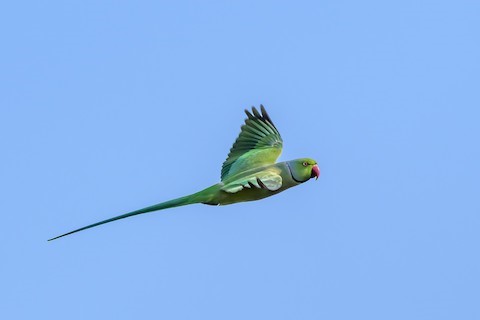
Rose-ringed Parakeet, male in flight showing all-green upperparts. (Green Park Extension, New Delhi, India; March 17, 2019.) © Nitin Chandra
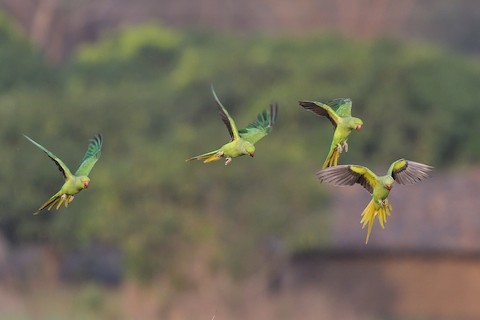
Rose-ringed Parakeet, females showing largely yellow underwings and undertails. (Mavinkoppa, Dharwad, Karnataka, India; May 19, 2019.) © Hemanth Byatroy
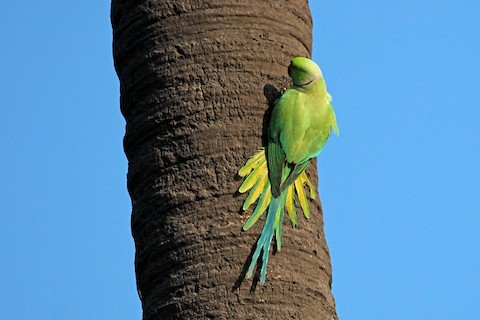
Rose-ringed Parakeet, male, showing differing coloration of tail feathers, turquoise on the two central and yellow on the rest. (Bahour Lake, Puducherry, India; February 25, 2018.) © Panchapakesan Jeganathan
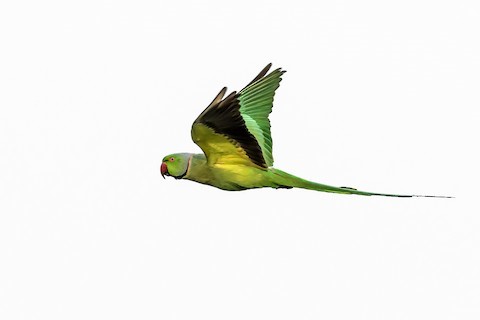
Rose-ringed Parakeet, male in flight showing yellow wing-linings. (Green Park Extension, New Delhi, India; April 9, 2019.) © Nitin Chandra
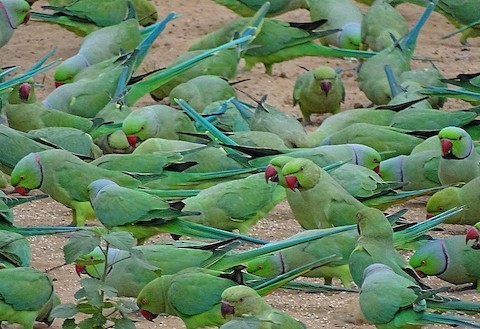
Rose-ringed Parakeet, feeding flock. (Pushkar, Ajmer, Rajasthan, India; August 7, 2018.) © Jens Thalund
Voice. Most common calls have a squeaky tone. Some are sharp and abrupt: Some are more textured and resonant:Also soft, buzzy shrieks:
Cf. Alexandrine Parakeet. Rose-ringed and Alexandrine Parakeets are closely related, similar species that occur together over wide areas of their natural ranges and areas with introduced populations, including large portions of southern Asia, the Middle East, and Europe. Males and females of the two species share the same distinctive plumages. Alexandrine is much larger (total length about 60 cm versus 40 cm) and more heavily built, especially the bill, but this can sometimes be difficult to judge without a direct comparison.
Apart from size, the most consistent differences between them are on the wings and tail. On the wings, Alexandrine has small reddish patches that are visible when the wing is folded or spread, whereas Rose-ringed’s wings are all-green above. On the underwings, Rose-ringed has yellow linings, whereas Alexandrine’s underwings are generally green. On the tail, Rose-ringed’s long central tail feathers typically show as blue, or at least bluish, when seen in good light, whereas Alexandrine’s are green.
Notes
Polytypic species consisting of four recognized subspecies.
References
BirdLife International. 2018. Psittacula krameri. The IUCN Red List of Threatened Species 2018: e.T22685441A132057695. https://dx.doi.org/10.2305/IUCN.UK.2018-2.RLTS.T22685441A132057695.en. (Accessed September 5, 2020.)
eBird. 2020. eBird: An online database of bird distribution and abundance. Cornell Lab of Ornithology, Ithaca, N.Y. http://www.ebird.org. (Accessed September 5, 2020.)
Forshaw, J.M. 2010. Parrots of the World. Princeton University Press, Princeton, N.J.
Garcia-del-Rey, E. 2011. Field Guide to the Birds of Macaronesia: Azores, Madeira, Canary Islands, Cape Verde. Lynx Editions, Barcelona.
Garcia-del-Rey, E. 2018. Birds of the Canary Islands. Christopher Helm, London.
Juniper, T., and M. Parr. 1998. Parrots: A Guide to Parrots of the World. Yale University Press.
Kirwan, G.M., A. Levesque, M. Oberle, and C.J. Sharpe. 2019. Birds of the West Indies. Lynx Edicions, Barcelona.
Mullarney, K., L. Svensson, D. Zetterström, and P.J. Grant. 1999. Birds of Europe. Princeton University Press.
Pratt, H.D., P.L. Bruner, and D.G. Berrett. 1987. A Field Guide to the Birds of Hawaii and the Tropical Pacific. Princeton University Press.
Pyle, R.L., and P. Pyle. 2017. The Birds of the Hawaiian Islands: Occurrence, History, Distribution, and Status. Version 2 (January 1, 2017). http://hbs.bishopmuseum.org/birds/rlp-monograph/. B.P. Bishop Museum, Honolulu, Hawaii.
van Perlo, B. 2002. Birds of Western and Central Africa. Princeton University Press.
Xeno-Canto. 2020. Rose-ringed Parakeet – Psittacula krameri. https://www.xeno-canto.org/species/Psittacula-krameri. (Accessed September 5, 2020.)
